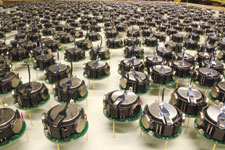
Each low-cost, three-legged robot moves around with the help of two motors that vibrate at different frequencies, causing it to move across a surface on its rigid legs. It communicates with its neighbours, measuring their proximity through infrared transmitters and receivers. After being programmed to form a set shape such as the letter K or a starfish, each one in turn navigates its way to a final position using primitive behaviours – following the edge of a group, tracking a distance from the origin or maintaining a sense of relative location. If a traffic jam forms, nearby robots sense it and co-operate to fix the problem.

“Each robot is identical and is controlled by exactly the same program,” explains Dr Michael Rubenstein from Harvard University School of Engineering & Applied Sciences. “The only thing they have to go on to make decisions is what their neighbours are doing.” The robots are much simpler than many conventional robots, for example individuals may have trouble moving in a straight line; but at full scale the smart algorithm controlling them overcomes individual limitations and the robots can complete a human-specified task – like assembling into a particular shape.
Infrared control
Although the Kilobots can communicate with their neighbours, they have no sense of a broader environment. Four robots mark out the origin of a coordinate system while the remaining robots receive a 2D image of the shape. The initial set of instructions is beamed to the robots via infrared, after which they work autonomously, requiring no further human intervention. Starting with a random selection, if they are in a position to move they motor slowly around, flashing their infrared lights to broadcast information to other Kilobots nearby. They then assemble into the specified shape.
Inspiration from nature
The self-organising behaviour was inspired by the cooperative activities of insects like army ants. The Harvard team aims to provide a physical model for advancing the understanding of collective behaviour, creating artificial swarms with the capabilities of natural ones. The Kilobot demonstrates how simple machines performing simple behaviours can create complexity in a group and that robots can be programmed to perform useful functions by coordinating interactions among many individuals. “The beauty of biological systems is that they are elegantly simple yet in large numbers accomplish the seemingly impossible. At some level you no longer even see the individuals, you just see the collective as an entity in itself,” says research leader Radhika Nagpal, professor of computer science at the Harvard School of Engineering and Applied Sciences.
Practical testing of advanced algorithms
Although there is a large amount of research on algorithms and control methods for groups of decentralised, cooperating robots, they are generally validated by simulation only. The Kilobot goes well beyond the state-of-the-art in robotics by allowing the practical testing of advanced algorithms on a large scale through the use of cheap materials and simple programming. “Performing complex behaviours with as little hardware as possible to keep costs down encompasses the spirit of Kilobots,” says Rubenstein.
An important milestone
The technology is being heralded as an important milestone in the development of collective artificial intelligence. “Increasingly we’re going to see large numbers of robots working together to solve problems,” adds Nagpal. The researchers believe that robot swarms might one day tunnel through rubble to find survivors, remove contaminants from the environment, assist dwindling bee populations in pollinating crops and self-assemble to form support structures in collapsed buildings. Success in getting so many robots to self-organise could be a significant milestone in the development of nanotechnology and a collective artificial intelligence, according to the researchers. The next stage is to refine the intelligence and develop smaller robots capable of the same tasks, eventually aiming for the nano scale.
For more information visit http://tinyurl.com/k96uqb4

© Technews Publishing (Pty) Ltd | All Rights Reserved